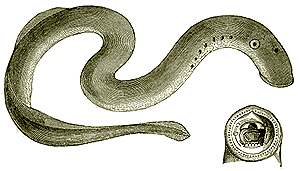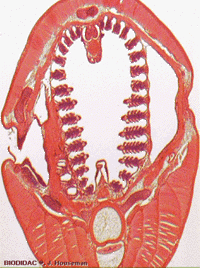
| Palaeos: |  |
Vertebrata |
| The Vertebrates | Hyperoartia |
| Page Back | Unit Home | Unit Dendrogram | Unit References | Taxon Index | Page Next |
| Unit Back | Vertebrates Home | Vertebrate Dendrograms | Vertebrate References | Glossary | Unit Next |
|
Abbreviated Dendrogram
Chordata | Craniata |--Myllokunmingia `--+--Myxinoidea `--Vertebrata |--Jamoytiiformes | |-- Jamoytius | `-- Euphanerops |--Hyperoartia (= Petromyzontiformes) | |- Hardistiella montanensis Janvier & Lund, 1983 [paraphyletic Mayomyzoninae] | `--+-- Mayomyzon pieckoensis Bardack & Zangerl, 1962; [paraphyletic Mayomyzoninae] | `--+- Pipiscius zangerli Bardack & Richardson, 1977 [paraphyletic Mayomyzoninae] | `--+-- Priscomyzon riniensis Gess, Coates & Rubidge, 2006; | `--+-- Mesomyzon mengae Chang, Zhang & Miao, 2006; | `-- Petromyzontidae `--+--Conodonta `--+--Anaspida `--+--Pteraspidomorphi `--+==Thelodonti `--+==Cephalaspidomorphi `--Gnathostomata |
Contents
Overview |
Hyperoartia, also known as the Petromyzontiformes, include the modern lampreys (sometimes incorrectly called "eels", because of their superficial appaearnce, they are unrelated and far more primitive) and their fossil relatives, The discovery of the fossil Priscomyzon riniensis, pushed back the oldest known occurence of true lampreys to the Late Devonian, and showing that these parasitic jawless fish that have barely changed since the mid Palaeozoic. The evidence of phylogeny, however, suggests that the lamprey lineage diverged much earlier from other vertebrates, rather than arising from ostracoderm fishes. The origin of Hyperoartia may therefore extend back to the early Paleozoic, if not earlier. Although other early jawless fish such as Endeiolepis and Euphanerops are included in this group, new research (Sansom et al) shows them to be a distinct group further up the fish family tree. BILL 061113, HAJ100314, MAK111022
 Hyperoartia: Lampreys and their ancestors. Hardistiella, Mayomyzon, Pipiscius. (= Petromyzontiformes)
Hyperoartia: Lampreys and their ancestors. Hardistiella, Mayomyzon, Pipiscius. (= Petromyzontiformes)
Range: Early Carboniferous to Recent
Phylogeny: Vertebrata:: (Anaspida + (Pteraspidomorphi + Thelodonti)) + *: Euphanerops (Janvier) + Petromyzontiformes.
Characters: Eel-shaped aspect; oral sucker with keratinous "teeth"; sucker reinforced by annular cartilage; sucker with the pumping velum; piston cartilage in lingual apparatus with pectinate keratinous "teeth" which rotate on the tip of the retractable piston cartilage; eyes relatively large, with lens, but no intrinsic muscles; extrinsic eye muscles almost same as gnathostomes; $ single median dorsal nasohypophysial opening for both the olfactory organ and a blind hypophysial tube including the hypophysis (hypophysial tube may be remnant of primitive nasopharyngeal duct, but see The Basisphenoid); translucent pineal spot; true cartilagenous braincase plus cranial cartilage plates and bars; labyrinth with two vertical semicircular canals; seven gill openings; gill pouches large and posteriorly placed; spine-shaped process on gill arches; unjointed "branchial basket" for gills; arches external to gill pouches and branchial circulation; small cartilaginous dorsal arcualia (basidorsals and interdorsals) on notochord; loss or absence of anal fin; dorsal and caudal fins with thin cartilaginous radials associated with radial muscles; tail slightly hypocercal; loss or absence of mineralized exoskeleton; no scales; large neuromasts present; ammocete larva and extensive larval stage; anadromous; genome probably has undergone one round of duplication from ancestral chordate.
Comment: Relationships of Euphanerops (previously known as Endeiolepis) with lampreys are proposed by Janvier 1996 and elsewhere but disputed by in view of new study by Sansom et al, is transferred to the new vertebrate clade Jamoytiiformes, which would mean that Petromyzontiformes and Hyperoartia are synonymised. For now we keep the possibility of either thesis open MAK111026
Links: Hyperoartia; Introduction to the Petromyzontiformes; Hyperoartia; Neuroethology: Swimming in the Lamprey; Evolution der Fische (German); Phylogénomique.
References: Janvier (1999); Shu et al. (1999).
 Petromyzontiformes: Lampreys and their ancestors. Hardistiella, Mayomyzon, Pipiscius.
Petromyzontiformes: Lampreys and their ancestors. Hardistiella, Mayomyzon, Pipiscius.
Range: Late Devonian to Recent
Phylogeny: Vertebrata ::: Euphanerops(?) + * ::: Petromyzontidae
Characters: : Body anguilliform; round, suckerlike jawless subterminal
mouth filled with rows of keratinous "teeth"; rasplike
"tongue"; internal ring of cartilage supports rim of mouth; 1 median
dorsal nasal opening; 2 semicircular canals; 7 gills similar to anaspids
arranged behind the orbit; vertebrae present; 2 dorsal fins; no bone; often
anadromous;  ammocoete larvae 3-7 yrs as sedentary filter feeders
filtering particles from mucous secretions; short-lived, parasitic adult form.
ammocoete larvae 3-7 yrs as sedentary filter feeders
filtering particles from mucous secretions; short-lived, parasitic adult form.
Links:: Introduction to the Petromyzontiformes; Svenska fiskar: havsnejonöga (Swedish); Geol 437 jawless fishes (NOT \AGNATHA\), Fall, 1995; Lampreys (Petromyzontiformes); Petromyzontiformes (mtDNA equence data); Petromyzontiform.
Image credits: top, from John Pojeta, Jr.; Right: unidentified lamprey from Fishbase. Left: Cross-section of an ammocete larva at the level of the gills from BIODIDAC. Note the external gill supports that have become a key issue in Mallat's theory of the origin of jaws. The (even more significant) internal gill supports are not readily identifiable in this image. APW040314.
Hardistiella montanensis Janvier & Lund, 1983
Range: Carboniferous
Phylogeny: Petromyzontiformes : * (Paraphyletic Mayomyzoninae) ::: (Petromyzontidae
Comments: Hardistiella is the oldest known lamprey, of uncertain relationships. Lampreys are jawless vertebrates that lack, primitively, any sort of bone tissue or teeth. Modern lampreys have two different life styles. Most are filter feeders, but some have an adult stage in which they predate upon fish by means of sharp cornified rasping projections upon a “tongue”. Hardistiella shows no evidence of rasping structures, but we do not know whether they are mature or not. BILL 061113
Links: Anaspida..
Mayomyzon pieckoensis Bardack & Zangerl, 1962
Range: Carboniferous
Phylogeny: Petromyzontiformes ::: * (Paraphyletic Mayomyzoninae) ::: (Petromyzontidae
Characters: Piston cartilage in lingual apparatus (Janvier1997)
Comments: Mayomyzon is the best known fossil lamprey and resembles extant lampreys in many respects, except for the somewhat stouter body shape, smaller gill pouches, and coalescent dorsal and caudal fins. Mayomyzon possessed as piston cartilage and, thus, a complex "tongue"-like apparatus. BILL 061113
Links: Hyperoartia - Tree of Life Web.
Pipiscius zangerli Gess, Coates & Rubidge, 2006
Range: Carboniferous
Phylogeny: Petromyzontiformes ::: * (Paraphyletic Mayomyzoninae) ::: (Petromyzontidae
Characters: Horny plates or denticles on sucker (Janvier1997)
Comments: A poorly known lamprey that possessed a rouded sucker armed with polygonal horny plates. BILL 061113
Links: Hyperoartia - Tree of Life Web.
Priscomyzon riniensis Bardack & Richardson, 1977
Range: Famennian (Late Devonian) of South Africa
Phylogeny: Petromyzontiformes::: (Mesomyzon + Petromyzontidae) + *
Characters: large oral disc, the first direct evidence of circumoral teeth and a well preserved branchial basket (Gess et al)
Comments: earliest known lamprey; marine/estuarine form that is more advanced ( more conventionally lamprey-like) than the later Carboniferous forms
Links:
Mesomyzon mengae Chang, Zhang & Miao, 2006
Range: Early Cret. EAs
Phylogeny: Petromyzontiformes ::: Priscomyzon + (Petromyzontidae + *).
Links: Hyperoartia - Tree of Life Web.
Petromyzontidae: Ichthyomyzon, Petromyzon, Caspiomyzon, Geotria, Mordacia, Eudontomyzon, Tetrapleurodon, Entosphenus, Lethenteron, and Lampetra
Range: Recent
Phylogeny: Petromyzontiformes ::: Priscomyzon + (Mesomyzon + *).
Characters: Seven gill openings, gill pouches larger and more posteriorly placed, eel-shaped aspect. (Janvier1997)
Comments: Extant lampreys. "The interrelationships of the ten extant genera is still unclear, but it is currently admitted that the organisation of the horny denticles of the sucker in Ichthyomyzon, Petromyzon and Caspiomyzon is primitive for the group. It is also quite similar to that found in one of the fossil lamprey, Pipiscius." - Janvier1997
Links: Hyperoartia - Tree of Life Web (same as Janvier 1997 ref); Wikipedia, doubtless more links could be added. See also Hyperoartia links (these haven't been checked in some time though some many may no longer be current). MAK111022
| Page Back | Unit Home | Glossary | Page Top | Page Next |